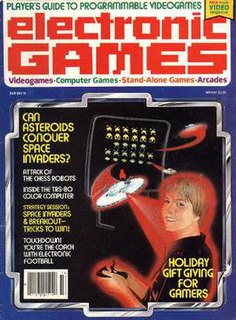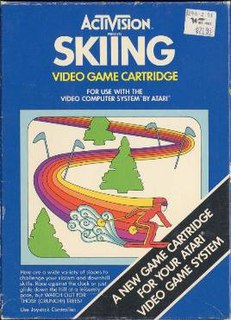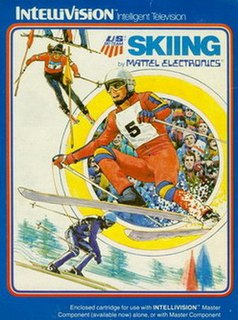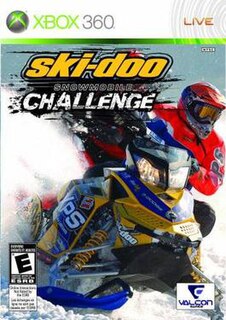
Snowboarding is a recreational activity and Winter Olympic and Paralympic sport that involves descending a snow-covered slope while standing on a snowboard attached to a rider's feet.
A jackass is a male donkey.

Game Freak Inc. is a Japanese video game developer, best known as the primary developer of the Pokémon series of role-playing video games published by Nintendo.

That's Incredible! is an American reality television show that aired on the ABC television network from 1980 to 1984. In the tradition of You Asked for It, Ripley's Believe It or Not! and Real People, the show featured people performing stunts and reenactments of allegedly paranormal events. The show also often featured people with unusual talents, such as speed-talker John Moschitta, Jr., who made his first national television appearance on the show, as well as scientific, medical, and technological breakthroughs such as the Taser and cryogenic corneal reshaping by lathe keratomileusis. The show's catchphrase said by one its hosts at the conclusion of a particularly amazing segment was the same as its title: "That's incredible!"

Famitsu, formerly Famicom Tsūshin, is a line of Japanese video game magazines published by Enterbrain, Inc. and Tokuma. Famitsu is published in both weekly and monthly formats as well as in the form of special topical issues devoted to only one console, video game company, or other theme. Shūkan Famitsū, the original Famitsū publication, is considered the most widely read and respected video game news magazine in Japan. From October 28, 2011 Enterbrain began releasing the digital version of the magazine exclusively on BookWalker weekly.
Twin Galaxies is an Organization and Social Media / Social Networking platform that facilitates interaction, achievement, recognition, and competition between people involved in the culture and activity of playing video games. Guinness World Records considers Twin Galaxies to be an official supplier of verified world records.

Winter Games is a sports video game developed by Epyx, based on sports featured in the Winter Olympic Games.

Electronic Games was the first dedicated video game magazine published in the United States and ran from October 15, 1981 to 1997 under different titles. It was co-founded by Bill Kunkel, Joyce Worley, and Arnie Katz, and is not to be confused with Electronic Gaming Monthly.
VideoGames & Computer Entertainment was an American magazine dedicated to covering video games on computers, home consoles and arcades. It was published by LFP, Inc. from the late 1980s until the mid-1990s. Offering game reviews, previews, game strategies and cheat codes as well as coverage of the general industry, VG&CE was also one of the first magazines to cover both home console and computer games. The magazine gave out annual awards in a variety of categories, divided between the best of home video games and computer video games. The magazine was known for its artwork by Alan Hunter and other freelance artists.
Shaun Murray is an American four-time World champion wakeboarder, and the main character featured in Activision's video game Wakeboarding Unleashed featuring Shaun Murray developed by Shaba Games and released on June 3, 2003 for PlayStation 2, Xbox and Game Boy Advance. PC port developed by Beenox and published by Aspyr released on December 22, 2003.

Slalom is a skiing video game in which the player races in a series of downhill slalom runs while navigating past flags and obstacles before time expires. It was developed by Rare and first released by Nintendo for the Nintendo VS. System in 1986. It was then released for the Nintendo Entertainment System (NES) in North America in March 1987 and in Europe later that year. The game was developed by Tim and Chris Stamper and its music was composed by David Wise.

Tommy Moe's Winter Extreme: Skiing & Snowboarding is a winter sports video game for the Super Nintendo Entertainment System that uses skiing and snowboarding as extreme sports in either freestyle, training mode, or competition mode. The game is known as Ski Paradise with Snowboard in Japan and Val d'Isere Championship in Europe.

Skiing is a video game cartridge for the Atari 2600. It was authored by Bob Whitehead and released by Activision in 1980.

Skiing is a sports video game produced by Mattel and released for its Intellivision video game system in 1980. Up to six players compete individually on either a downhill or slalom course to see who can complete the course the fastest. For the game's initial release, Mattel obtained a license from the U. S. Ski Team and used its name and logo in the game's box art. In 1988, INTV Corporation released an enhanced version of the game entitled Mountain Madness: Super Pro Skiing.

Ski-Doo: Snowmobile Challenge is a snowmobiling video game developed by Swedish studio ColdWood Interactive and published by Valcon Games for PlayStation 3, Xbox 360, and Wii. The game has a relatively low amount of achievements for Xbox 360 (23) and trophies for PS3 (28).
Nihon Bussan Co., Ltd. was a Japanese video game manufacturer. The company had its headquarters in Kita-ku, Osaka. In the past they had also manufactured and sold yachts.
A vertically scrolling video game or vertical scroller is a video game in which the player views the field of play principally from a top-down perspective, while the background scrolls from the top of the screen to the bottom to create the illusion that the player character is moving in the game world.

The Fairchild Channel F is a game console released by Fairchild Semiconductor in November 1976. It has the distinction of being the first programmable ROM cartridge–based video game console, and the first console to use a microprocessor. It was launched as the Video Entertainment System, or VES, but when Atari released their VCS the next year, Fairchild renamed its machine.

Video is a discontinued American consumer electronics magazine that was published from 1977 to 1999 by Reese Communications with a focus on video and audio devices. The magazine showcases new audiovisual products, analyzes current practices and trends in the field, and provides critical reviews of newly marketed products and equipment. During its early years, it competed fiercely with contemporary journals like Video Review and Video Buyer's Review—ultimately culminating in a 1980 trademark infringement suit over use of the term "Video Buyer's Guide". In March 1995, Video was acquired from Reese by Hachette Filipacchi, and in 1999 it was merged with their bi-monthly Sound & Image magazine to become Sound & Vision.















